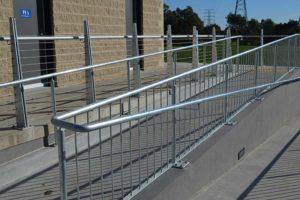CASE STUDY - ARTS CENTRE MELBOURNE BALUSTRADE COMPLIANCE UPGRADE WORKS

The Building Code of Australia (BCA) refers to stairways in D3.3(c) and requires compliance with AS1428.1 for stairways that are required to have access features. The Commission’s view is that all stairways, other than those specifically exempted under the BCA, should have these features for access and safety reasons.
Handrails and kerbs or kerb rails on ramps are important to people with a range of disabilities, for example, people who are blind or vision impaired, people with a mobility disability and people who have an intellectual disability or brain injury.
Two handrails are required as some people may not have the use of both hands in which case they may need to use either the left or right handrail. Kerb rails are required to reduce the chances of people who use wheelchairs running off the edge of the ramp or catching their toe plate behind the handrail supports and as a result tipping out of their chair.
The specifications relating to the ergonomic design of handrails ensure they can be used by all people, especially those with a disability that affects hand or arm function. Stainless steel fabrication can be utilized to create durable and reliable handrails that ensure safety and longevity. Continuous handrails that allow a user’s hand to maintain a continuous hold on the handrail assist in safe movement throughout the complete journey either up or down a ramp.
The ends of handrails must be designed and constructed to reduce the incidence of injury to pedestrians.
To be effective handrails must be within the design criteria set out in AS1428.1.
This is achieved by ensuring:
- Clearances of the top arc of 270° throughout their full length.
- The ends are terminated by returning to a side wall or downwards on to a post or by returning back 180° on themselves.
- Ends of handrails at the bottom and top of ramp must horizontally extend for at least 300mm from the transition in change of plane.
- Handrails on both sides of the ramp are 30 – 50mm diameter.
Raised dome buttons are only required on the ends of handrails where TGSIs are exempt from being used, for example, in Aged Residential Care facilities.
To be effective kerb rails must be within the design criteria set out in AS1428.1.
This is achieved by ensuring:
- Correct placement and dimensioning of the kerb rails.
- Location of the kerb rails in relation to the handrails





